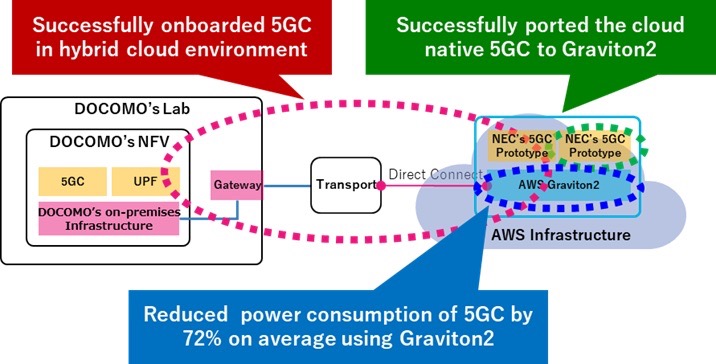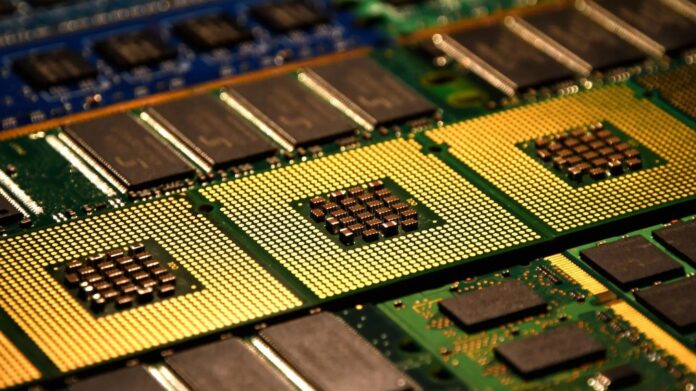Their trial conducted on Graviton2 processors yielded an average power reduction of 72% compared to Intel, the companies claimed
Japanese telco NTT DoCoMo and NEC Corp. announced the completion of a technical trial to test energy efficiency and performance of Amazon Web Services’ (AWS) Graviton2 processors, when used to operate what they described as “key elements” of a 5G Core (5GC) network. The trial focused on a 5GC hybrid cloud environment using Graviton2 processors and Docomo’s on-premises Network Functions Virtualization Infrastructure (NFVI).
The companies claim that the trial demonstrated an average of 72% reduction in power consumption compared to Intel x86 processors, using NEC’s 5G core software running on AWS Graviton2. The Graviton2 processor, designed by AWS, has been created to provide optimal per performance for workloads operating on AWS’s Elastic Compute Cloud (EC2) scalable computing environment.

The companies said the dramatic efficiency was thanks to the combination of NEC’s cloud-native 5GC software and the efficiency Graviton2 design. Graviton2 is not custom-designed to operate 5G workloads, but it’s a general-purpose processor that AWS says is suited for application services, High-Performance Computing (HPC), Machine Learning (ML) inference, video encoding and other functions, including running microservices, so NTT Docomo and NEC’s interest in running cloud-native 5G core operations on the high-performance silicon is understandable.
Custom-built by AWS, the Graviton2 uses Arm’s 64-bit Neoverse N1 core chip architecture and mesh interconnect, the work of the AWS silicon design team Amazon acquired in 2015 when it bought Arm semiconductor designer specialist Annapurna Labs. Arm’s designs use a Reduced Instruction Set Computer (RISC) architecture; RISC chips are generally simpler in design and more scalable than the Complex Instruction Set Computer (CISC) architecture favored by Intel in its x86 processors.
AWS announced the Graviton2 in 2019 and made instances of its EC2 service available on the platform beginning in 2020. Since then, AWS has announced the Graviton3, which the company claims provides up to 25% better compute performance, double the floating-point performance, and double the cryptographic workload performance than the Graviton2. Other improvements in Graviton3 include 3x better ML workload performance and 50% more memory bandwidth, owing to the Graviton3’s support for DDR5 memory compared to DDR4 on the Graviton2. Neither NTT DoCoMo nor NEC mentioned Graviton3 in the press release, so it’s still an open question as to how NEC’s 5GC network software runs on the newest AWS silicon.
NTT DoCoMo and NEC are frequent collaborators. The companies worked together with Fujitsu in June to announce joint 6G trials, with indoor trials scheduled for this year, followed by outdoor trials in March 2023. Commercial services are expected to launch in 2030. 6G technologies have not yet been standardized.
The companies hope that the trials will lead to technologies that are “resistant to obstruction” and “realizes stable high-speed wireless communication over 100 Gbps.” Fujitsu said that to keep speed and capacity high, while size and power remains low, it must develop high-frequency wireless devices that utilize compound semiconductors such as gallium nitride (GaN) and indium phosphorus (InP).
Last December, NTT DoCoMo and NEC announced interoperability testing for 5G Standalone (SA) using a 5G base station baseband unit (5G CU/DU) conforming to Open RAN interface specifications and radio units (RUs) of different vendors. Earlier in 2021, NEC announced the joint development of RAN Intelligent Controllers (RICs) with NTT DoCoMo, supporting intelligent Radio Access Networks (RANs). The two companies said they aim to reduce RAN operational costs, improve performance and reduce power consumption through the use of RIC.

